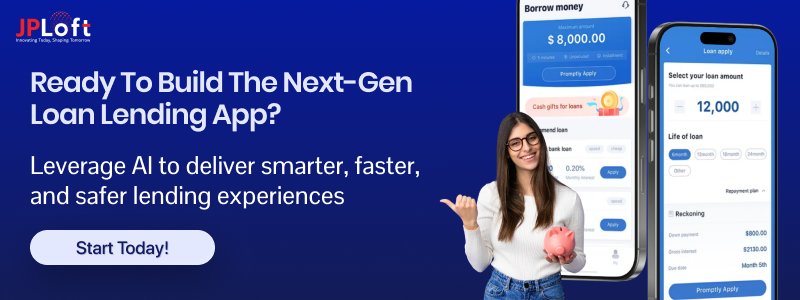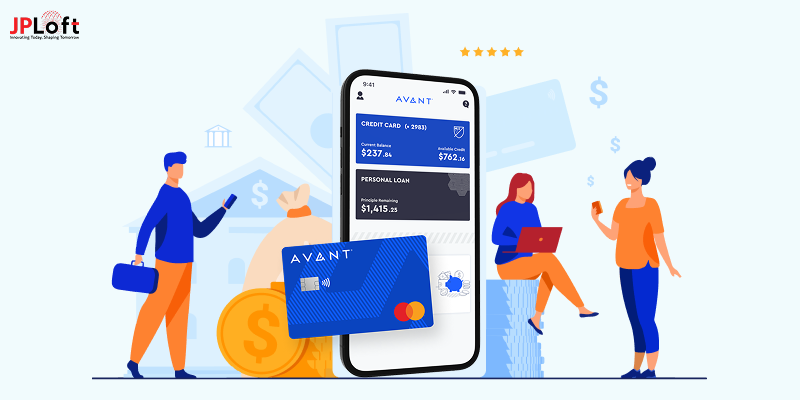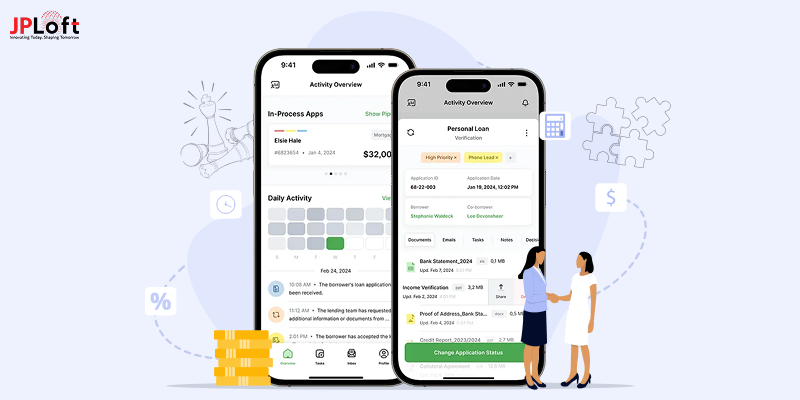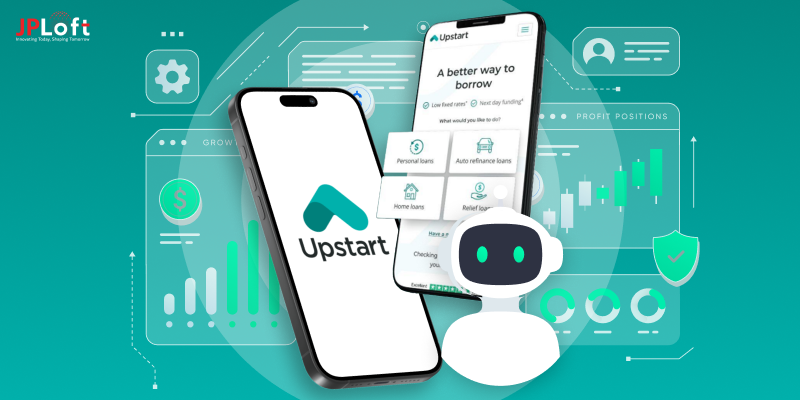Did you know that Artificial Intelligence (AI) is revolutionizing the loan lending industry faster than ever?
From cutting down approval times to reducing fraud risks and improving borrower experiences, AI isn’t just a buzzword, it’s transforming how lenders and borrowers interact.
What is the role of AI in loan lending apps? AI in loan lending apps helps automate tasks like credit scoring, fraud detection, and personalized loan offers, making the process faster, safer, and smarter.
If you're in the fintech space or thinking about building a loan app, understanding how AI works under the hood could be a game-changer for your success.
Let’s dive deeper into how this powerful technology is reshaping digital lending and how you can leverage it to stay ahead in the game.
Overview of AI and Loan Lending Apps
Let’s face it, traditional lending processes are slow, manual, and full of paperwork.
That’s where Artificial Intelligence in loan lending apps steps in to modernize and streamline everything.
With AI in loan lending apps, you can automate credit checks, assess risk more accurately, detect fraud in real-time, and offer personalized loan experiences all without drowning in data or delays.
These apps use machine learning to evaluate borrower behaviour, income patterns, and even digital footprints, enabling smarter, faster decisions with less human error.
AI doesn’t just speed up approvals, it also boosts customer trust and retention by making the process more transparent and intuitive.
If you're developing a loan lending app, using AI in loan lending apps isn’t just a competitive advantage anymore; it's an expectation.
And trust us, your future borrowers will thank you for it.
Importance of Artificial Intelligence in Loan Lending Apps
In today’s financial world, Artificial Intelligence (AI) technologies are revolutionizing the loan lending industry in ways we couldn’t have imagined a decade ago.
From automated approvals to real-time fraud detection, AI is no longer a “nice-to-have”; it’s a necessity. In fact, according to a report by McKinsey, financial institutions that adopt AI-driven lending processes can reduce underwriting costs by up to 30% and improve customer satisfaction by 25%.
So, what exactly makes Artificial Intelligence in loan lending apps so important?
Let’s dive into four key reasons:
A] Smarter Credit Scoring
Traditional systems miss key data, but AI analyzes alternative sources - crucial when calculating the true cost to create a loan lending app that serves underbanked populations.
Artificial Intelligence in loan lending apps changes that. It analyzes alternative data sources like social behaviour, online transactions, and mobile usage patterns, delivering deeper, fairer, and more inclusive credit assessments.
Stat: Over 45 million Americans are “credit invisible.” AI helps bring them into the lending ecosystem by looking beyond FICO scores.
B] Faster and Accurate Decision-Making
One of the core importance of AI in a loan lending app lies in speed and precision.
This makes it important for lending & money transfer app development, where speed creates a competitive advantage.
AI can analyze thousands of data points within seconds, something human underwriters could take hours or even days to process.
This real-time decision-making not only enhances efficiency but also drastically reduces the time it takes for users to get approved or rejected.
Fact: AI reduces loan processing time by up to 70%, according to a study by Deloitte.
C] Enhanced Fraud Detection and Risk Management
Fraud is one of the biggest threats in digital lending, but AI is a powerful shield.
By identifying suspicious patterns, geolocation mismatches, and unusual behavioural changes, AI helps prevent fraudulent applications before they cause damage. This is critical for building trust in your platform.
Stat: AI can detect fraudulent behaviour with an accuracy rate of 90% or more, making it one of the most effective tools for real-time fraud mitigation.
D] Personalized Lending Experiences
AI in loan lending platforms empowers lenders to offer hyper-personalized loan options. Whether it’s adjusting interest rates, repayment terms, or loan types based on individual behaviour and history, AI ensures users get offers that truly fit them.
User Insight: Personalization can increase customer retention by up to 40%, according to Epsilon research.
This isn't just a better user experience, it's also a huge business advantage.
15+ Key Roles of Artificial Intelligence in Loan Lending Apps
AI-powered loan lending apps are changing the game in digital finance. They make borrowing faster, safer, and more personalized than ever before.
From fraud detection to dynamic pricing, AI is behind every smart decision. Here’s how Artificial Intelligence is powering the future of loan lending.
1. Fraud Detection – AI Is a Digital Watchdog
AI in loan lending apps plays a critical role in fraud detection by monitoring user behavior, verifying identity documents, and flagging anomalies—all in real time. It’s like a smart fraud bouncer, quietly working behind the scenes to keep your platform secure.
Unlike manual reviews that are time-consuming and prone to human error, AI in fraud detection works instantly and gets smarter with every transaction.
How AI helps with fraud detection in loan lending apps:
-
Real-time risk analysis: AI analyzes user data and transaction patterns to detect unusual or risky behavior immediately.
-
Document verification: AI-powered systems can spot forged documents or mismatched details during onboarding.
-
Behavioral tracking: Monitors login frequency, device use, and time-of-day patterns to identify suspicious activity.
-
Reduced losses: Studies show AI can cut fraud-related losses by up to 80% on digital lending platforms.
That’s the kind of smart security your users—and your bottom line—will thank you for.
2. Credit Analysis – AI Reimagines Creditworthiness Evaluation
Traditional credit scoring methods miss out on many worthy borrowers, especially those without long credit histories.
AI reshapes this by using non-traditional data such as mobile usage, transaction frequency, utility payments, and even social media signals to offer a far more inclusive and precise credit analysis.
How AI innovates credit analysis:
-
Holistic risk modeling: Incorporates digital and behavioral signals alongside bureau data.
-
Real-time scoring updates: Adjusts risk models as soon as new data (e.g., salary change or new loan) is detected.
-
Global data sourcing: Supports analysis across multiple geographies and currencies for international lending.
-
Unbanked population access: Enables credit for first-time borrowers without credit history using alternative indicators.
3. Regulatory Compliance – AI Ensures Adherence with Minimal Overhead
AI acts as a digital compliance officer, scanning every transaction and decision against regulatory frameworks to avoid legal penalties and ensure fairness.
It monitors rule changes globally and adapts decision workflows accordingly, eliminating costly manual compliance checks.
How AI supports compliance:
-
Dynamic rule engines: Automatically update lending rules based on jurisdictional changes.
-
End-to-end traceability: Keeps a detailed audit trail of every credit decision for regulators.
-
Bias monitoring tools: Identify and correct for unintentional discrimination in lending practices.
-
Regulatory intelligence: Alerts teams to potential compliance gaps before they become liabilities.
4. Improved Customer Experience – AI as a 24/7 Digital Loan Advisor
Customers want fast, frictionless, and personalized service, AI delivers this through intelligent virtual assistants, contextual product suggestions, and real-time support.
By resolving queries instantly and offering actionable financial advice, AI dramatically enhances user satisfaction and loyalty.
How AI enhances customer experience:
-
Conversational interfaces: Understands natural language to provide accurate, human-like responses.
-
Smart notifications: Sends reminders, offers, and insights based on user activity and financial patterns.
-
Instant onboarding support: Guides new users through registration, KYC, and application without human intervention.
-
Personalized finance coaching: Offers tips on improving credit, managing loans, and budgeting.
5. Automated Document Processing – AI Accelerates Paperwork Handling
Loan apps can be bottlenecked by document processing.
AI uses OCR and natural language processing to read, validate, and categorize documents instantly, whether scanned IDs or complex financial statements.
This eliminates manual errors and speeds up the decision process.
How AI automates document workflows:
-
Smart field extraction: Identifies and extracts names, dates, income, and addresses with 98 %+ accuracy.
-
Multi-language recognition: Supports ID and document analysis across global languages and formats.
-
Consistency cross-checking: Matches data across multiple documents to detect inconsistencies or fraud.
-
Workflow integration: Automatically feeds verified data into approval pipelines without manual input.
6. Automated AI Loan Approval – Fast, Fair, and Transparent
AI enables truly automated loan decisions by combining real-time risk assessment, policy enforcement, and customer profiling.
It ensures fairness and compliance while approving eligible applicants in seconds instead of days, enhancing platform competitiveness.
How AI streamlines approvals:
-
Instant eligibility checks: Evaluates user inputs and attached data against lending criteria instantly.
-
Explainable AI models: Generate understandable justifications for approvals or rejections.
-
Integrated compliance: Applies local lending rules during approval, eliminating legal violations.
-
Fallback rules: Flags edge cases for human review when needed.
7. Automated Credit Assessment – Smarter Credit Judgments in Seconds
AI can assess creditworthiness with more depth and speed than any human analyst.
It can score applicants who lack traditional credit history by analyzing alternative data sources and learning patterns that indicate repayment ability.
How AI advances credit assessment:
-
Behavioral scoring models: Use machine learning to detect hidden indicators of trustworthiness.
-
Open banking data integration: Incorporates bank transactions and cash flow for a real-time credit picture.
-
Micro-lending insights: Helps evaluate ultra-small loans with minimal data.
-
Risk segmentation: Groups applicants by nuanced credit risk levels instead of simple high/low labels.
8. Credit Decisioning – AI Makes Smarter Lending Calls
Credit decisions must balance opportunity and risk.
AI analyzes complex, non-linear interactions among variables that traditional models miss, such as income volatility, seasonal earnings, and shared expenses, to deliver far more precise credit calls.
How AI sharpens credit decisioning:
-
Deep learning models: Uncover hidden patterns and interactions between credit variables.
-
Scenario testing: Simulates various borrower outcomes to gauge risk under different conditions.
-
Real-time updates: Adjusts decisioning logic based on updated economic indicators.
-
Embedded fairness checks: Ensures all decisions pass ethical and legal standards.
9. Credit Score Simulation – AI Predicts How Actions Affect Scores
Credit score simulation with AI gives borrowers predictive power over their financial choices.
The best part AI plays in loan lending apps is that it takes the guesswork out of credit improvement by offering real-time simulations that show how different financial behaviours will impact a user’s credit score.
This empowers borrowers with predictive insight and encourages responsible borrowing habits, all while reducing credit risk for lenders.
How AI simulates credit scores:
-
Behavioural modelling: Simulates outcomes of actions like early repayments, credit limit increases, or missed EMIs.
-
Personalized scenarios: Tailors simulations based on the borrower's financial profile, not just generalized averages.
-
Education-driven engagement: Turns simulations into educational tools that boost financial literacy.
-
Gamified interfaces: Use interactive dashboards to encourage credit-healthy decisions.
10. Customized Financial Products – AI Designs Bespoke Loan Solutions
AI helps create customized financial products by analyzing borrower goals, income, and spending behaviour.
Loan apps can dynamically generate unique loan structures that meet user needs while optimizing for profit and risk.
How AI crafts custom products:
-
Modular product engineering: Builds flexible loan packages that adapt to borrower inputs and financial goals.
-
Real-time bundling: Automatically combines loans with savings products, insurance, or credit boosters.
-
Goal-based lending: Offers products aligned to specific goals like education, business, or emergency funding.
-
Lifecycle alignment: Adjusts product features as the borrower moves through different financial life stages.
11. Document Authentication – AI Guards Against Forgery
AI ensures that identity and income verification documents are authentic and untampered, protecting lenders from onboarding fraudulent borrowers.
It uses advanced visual pattern recognition and metadata analysis to catch even sophisticated forgeries.
How AI authenticates documents:
-
AI-powered forgery detection: Identifies anomalies like pixel distortion, text inconsistencies, or cloning.
-
Global template recognition: Supports passports, licenses, and ID formats from over 200 countries.
-
Smart watermarking analysis: Verifies holograms, security patterns, and ink quality.
-
Tampering history tracing: Detects signs of past manipulation, including edited metadata or image layering.
12. Loan Portfolio Management – AI Optimizes Portfolio Health
Loan portfolio management with AI helps lenders maintain a balanced, profitable, and resilient portfolio by identifying risks, optimizing allocations, and improving overall performance visibility.
AI continuously monitors and evaluates the health of a lender’s loan book, identifying patterns, suggesting rebalancing strategies, and minimizing concentration risk.
It ensures long-term profitability and reduces exposure to economic shifts.
How AI manages portfolios:
-
Segmentation by behaviour and risk: Group loans by similar repayment and risk patterns for targeted strategies.
-
Risk-weighted performance analysis: Evaluates portfolio returns adjusted for default probability.
-
Stress testing and forecasting: Predicts how external shocks like inflation or recession could impact repayments.
-
Early warning systems: Flags declining segments and offers, tailors action plans.
13. Predictive Analysis – AI Anticipates Borrower Behaviour
Great part here is: AI doesn’t just look at what has happened, it predicts what’s likely to happen next.
This foresight is vital for proactive risk mitigation, targeted marketing, and better borrower engagement. From defaults to early exits, AI sees them coming.
How AI predicts borrower behaviour:
-
Early default detection: Flags borrowers who show signs of financial distress before they miss payments.
-
Renewal and up-sell targeting: Identifies users likely to take larger loans or longer terms.
-
Churn prediction: Spot borrowers who may leave for competitors, enabling retention strategies.
-
Sentiment tracking: Analyzes communication tone in emails or chatbot interactions for mood and intent.
14. Creditworthiness Assessment – AI Brings Depth to Risk Evaluation
AI’s multi-layered analysis provides a more nuanced and inclusive view of creditworthiness.
This is particularly valuable in emerging markets and among gig economy workers, who may lack conventional credit footprints but are still reliable borrowers.
How AI deepens assessment:
-
Cash flow stability analysis: Examines bank account and mobile wallet data to assess income consistency.
-
Social signal integration: Leverages digital reputation, transaction reviews, and network credibility scores.
-
Peer-based scoring: Uses cluster analysis to compare users with similar financial behaviours and outcomes.
-
Reputation scoring: Adds digital trust indicators from platforms like e-commerce, utility payments, or ride-sharing.
15. Dynamic Pricing – AI Optimizes Interest Rates in Real Time
Rather than offering static interest rates, AI allows lending apps to personalize pricing dynamically based on evolving risk profiles, market conditions, and user behavior.
This enhances competitiveness and borrower satisfaction.
How AI enables dynamic pricing:
-
Real-time interest adjustment: Updates rates based on credit score changes or late payments.
-
Competitive benchmarking: Continuously compares with market rates and adjusts to maintain an edge.
-
Risk-based fee structures: Adjusts not only interest but also processing fees and penalties.
-
Smart promotional pricing: Offers short-term rate drops for retention or upselling.
16. Improved Efficiency in Loan Processing – AI Cuts Time and Costs
AI enables end-to-end automation of loan processing, from application to disbursal, with significantly fewer errors and faster turnaround.
It eliminates delays caused by manual reviews, paperwork, and outdated backend systems.
How AI boosts loan processing efficiency:
-
Parallel processing pipelines: Multiple checks (credit, fraud, KYC) happen simultaneously, not sequentially.
-
Real-time validation: Errors in documentation or application forms are flagged and corrected instantly.
-
Agent assist systems: Suggest the next best action to human staff, improving speed and consistency.
-
API-first integrations: Links seamlessly with banks, credit bureaus, and verification platforms.
17. Natural Language Processing (NLP) – AI Understands and Interacts Like a Human
It is no surprise, AI, powered by NLP, transforms how users interact with loan apps.
It reads documents, interprets borrower queries, and generates intelligent responses, streamlining communication and extracting value from unstructured data.
How AI leverages NLP:
-
Smart customer support: Handles multilingual, contextual borrower queries 24/7 with high-resolution accuracy.
-
Document intelligence: Extracts insights from unstructured documents like pay slips, offer letters, or contracts.
-
Voicebot capabilities: Enables verbal loan applications, particularly useful in low-literacy regions.
-
Compliance linguistics: Flags legally risky language in borrower communications or contracts.
18. Improved Loan Quality – AI Drives Smarter Lending Portfolios
Ultimately, the use of AI results in better quality loans, fewer defaults, higher repayment rates, and more profitable relationships.
AI continuously learns from every borrower interaction and repayment pattern to enhance its underwriting capabilities.
How AI improves loan quality:
-
Borrower behaviour prediction: Flags early signs of risk before they escalate.
-
Post-loan engagement: Recommends actions like top-ups or restructuring based on the borrower's situation.
-
Default modelling: Continuously improves based on real-world repayment behaviour.
-
Portfolio optimization: Rebalances lending focus toward high-performing segments.
There is no second thought to understand that Artificial Intelligence is revolutionizing the lending system in every way possible.
Moving on, let’s uncover the top apps and ways they are using AI in the payments & lending industry.
Top Loan Lending Apps & How They Are Using AI to Revolutionize Borrowing
Artificial Intelligence (AI) technologies are revolutionizing the loan lending industry by transforming everything from borrower evaluation to fraud detection and customer engagement.
Today’s most successful digital lenders are leveraging AI not as an add-on but as the core engine powering smarter decisions, faster approvals, and better user experiences.
Here’s a look at some of the top loan lending apps and how AI is transforming how loans are delivered, processed, and managed across the globe.
1. Upstart – Redefining Creditworthiness with AI-First Lending
Upstart is one of the pioneers proving how AI in loan lending can go beyond FICO scores.
It uses machine learning models to assess over 1,600 variables, including education, job history, and transaction behaviours, for making lending decisions.
AI’s critical role in Upstart:
-
AI-powered underwriting assesses risk more accurately than traditional models.
-
Delivers instant credit decisions using real-time applicant data.
-
Enables inclusive lending by qualifying users without an extensive credit history.
-
Reduces default rates while maintaining competitive approval rates.
2. LendingClub – AI for Smarter Loan Matching and Risk Analysis
LendingClub uses AI in loan lending apps to personalize borrower experiences and connect them with optimal loan terms.
Their AI models evaluate large volumes of data to match the right borrower with the right investor.
AI’s critical role in LendingClub:
-
Applies predictive analytics to assess borrower reliability.
-
Uses AI to dynamically price interest rates based on real-time credit risk.
-
Automates loan servicing decisions such as restructuring and early payoff strategies.
-
Enhances portfolio performance by segmenting and forecasting loan risks.
3. Zest AI – Building Fairer and Smarter Credit Models
Zest AI focuses on using machine learning to build more inclusive and explainable AI credit models for lenders.
Its platform helps financial institutions minimize bias and make smarter loan decisions.
AI’s critical role in Zest AI:
-
Develops interpretable machine learning models that regulators and banks trust.
-
Enables real-time credit decisioning for subprime and non-traditional borrowers.
-
Increases approval rates without increasing risk, using behavioral data.
-
Builds compliance-friendly AI lending algorithms that pass audits.
4. Branch – AI for Emerging Markets and Financial Inclusion
Branch is using AI to offer microloans in emerging markets where traditional credit data is scarce.
It is a strong example of how AI in loan lending apps can unlock financial access for the underserved.
AI’s critical role in the Branch:
-
AI evaluates alternative data like SMS records, mobile money use, and contact networks.
-
Automates credit scoring in regions with no formal credit infrastructure.
-
Offers real-time approvals with minimal friction or documentation.
-
Continuously adapts loan terms based on repayment patterns and behavioral risk signals.
5. MoneyLion – Financial Wellness Meets AI Intelligence
MoneyLion combines lending, investing, and budgeting into a single AI-powered super app.
It’s a frontrunner in showcasing the critical role of AI in loan lending apps, especially when it comes to financial wellness, risk modelling, and holistic credit support. For anyone developing an app like MoneyLion, AI should be embedded across every user interaction.
AI’s critical role in MoneyLion:
-
Integrates AI-driven credit builder loans that adapt to users' financial behaviour.
-
Uses predictive analytics to anticipate loan needs and offer tailored financial products.
-
Employs NLP chatbots to coach users on improving their credit and managing repayment.
-
Delivers dynamic pricing and payment plans through real-time behavioural analysis.
6. PaySense – Personalized Lending with Deep AI Integration
PaySense, acquired by PayU, delivers highly personalized loan experiences using deep AI integration.
It focuses on consumer lending, offering quick approvals and dynamic interest rates.
AI’s critical role in PaySense:
-
Analyzes bank transactions, employment data, and repayment trends to score users.
-
Personalizes loan amounts, EMI options, and tenure based on behavioral patterns.
-
Ensures real-time fraud detection during the application and disbursal stages.
-
Reduces default risk through AI-driven repayment prediction systems.
7. SoFi – AI for Wealth, Credit, and Lending Convergence
SoFi goes beyond loans, it integrates personal finance, investment, and insurance.
AI plays a key role in shaping user journeys, offering loans that align with holistic financial goals.
AI’s critical role in SoFi:
-
Delivers AI-based loan recommendations based on user goals and credit health.
-
Uses chatbots and NLP tools to guide borrowers through the application and management.
-
Predicts user lifecycle events to offer timely cross-sell and upsell opportunities.
-
Uses AI-driven pricing to offer the best possible rates with minimal default risk.
How JPLoft Can Help in Integrating Artificial Intelligence in Loan Lending Apps?
Looking to build the next breakthrough in fintech? As a leading loan lending app development company, JPLoft specializes in integrating cutting-edge Artificial Intelligence to transform how lending apps operate.
From intelligent credit scoring and automated loan approvals to fraud detection and predictive analytics, JPLoft infuses AI at every layer of your platform.
Whether you're aiming to create an AI-embedded loan lending app or just exploring new technologies, our experts deliver scalable, secure, and AI-powered solutions tailored to your business goals.
With JPLoft, you don’t just build a loan app, you build the future of smart, data-driven lending.
Conclusion
Artificial Intelligence (AI) is revolutionizing the loan lending industry by making borrowing faster, smarter, and more secure than ever before.
From AI-powered fraud detection and automated credit scoring to dynamic pricing and personalized loan recommendations, AI is transforming every aspect of digital lending.
Lenders leveraging AI in loan lending apps benefit from reduced risks, lower operational costs, and higher approval accuracy, while borrowers enjoy instant decisions, fairer assessments, and tailored financial products.
The success of platforms like Upstart, LendingClub, and MoneyLion proves that AI isn’t just a trend—it’s the future of lending.
If you’re ready to build a next-gen loan lending app powered by AI, now is the time to act. AI-driven lending isn’t just an advantage—it’s becoming the industry standard.
FAQs
AI speeds up loan approvals by analyzing vast amounts of data instantly, reducing manual errors, and providing real-time credit assessments for faster decisions.
Absolutely. AI-powered systems detect unusual behavior and verify documents in real time, significantly minimizing the risk of fraud and identity theft.
Yes! AI models use alternative data sources like income patterns and transaction behavior to assess creditworthiness, enabling more inclusive lending.
AI analyzes individual financial profiles and spending habits to customize loan amounts, interest rates, and repayment terms tailored to each borrower’s needs.
AI automates monitoring and reporting processes to ensure lending apps adhere to legal standards, reducing compliance risks and helping avoid penalties.













Share this blog